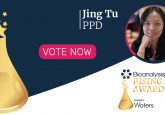Winner of the 2019 BOSCA announced!
Bioanalysis Zone and Bioanalysis are delighted to announce the winner of the 2019 Bioanalysis Outstanding Contribution Award (BOSCA). After much deliberation, the judges agreed that Dr Kevin Bateman (Merck; NJ, USA) was the most deserving of the title this year due to his outstanding research contributions, influence and engagement in the bioanalytical community.
Judge Neil Spooner (Spooner Bioanalytical Solutions; Hertford, UK) commented: “Kevin is a positive and enthusiastic leader in the field of quantitative bioanalysis. His forward thinking and vision of where we need to go as a community and how we get there are unparalleled. He is a leader in technological innovation and has a gift for turning ideas into reality, particularly where brave decisions need to be made about step changes in technology and workflows. Importantly and uniquely, what really makes Kevin stand out is his generosity with his knowledge, so enabling the pharmaceutical bioanalytical community to progress with technology in unison.”
To celebrate this announcement, the following Bioanalysis articles authored by Dr Bateman have been made available free of charge to members of Bioanalysis Zone:
- Direct quantitation of therapeutic antibodies for pharmacokinetic studies using immuno-purification and intact mass analysis
- Using miniature MS system with automatic blood sampler for preclinical pharmacokinetics study
- Top-down LC-MS quantitation of intact denatured and native monoclonal antibodies in biological samples
- Standardized workflows for increasing efficiency and productivity in discovery stage bioanalysis
We interviewed BOSCA winner, Kevin Bateman, about his current research projects and future perspective on drug discovery and development:
1. What was it that first attracted you to drug discovery and development?
When I was in university for my undergraduate studies, a speaker from Merck (MSD) came and spoke about the research that was being done at the labs in Montreal, Canada. It was fascinating to see how biologists, chemists and analytical scientists were working together to discover new drugs. I ended up doing my PhD in analytical chemistry, focused on biological mass spectrometry (the term proteomics didn’t exist back then). When I was finishing up, I applied to work at Merck, was hired, and have been there ever since.
2. What is your current research focus, and what bioanalytical techniques does this require you to utilize?
My current position is a broad one that requires me to have knowledge of many bioanalytical techniques. Of course, mass spectrometry is my first true love, but it’s not always the most appropriate technique. More recently I have been expanding my knowledge in ligand binding assays, qPCR technologies, cell-based assays and flow cytometry. The preanalytical space is also very important, so novel sample collection technologies for clinical studies are keeping me busy.
3. What have been the key challenges you have faced when developing new bioanalytical capabilities across small molecules, biologics and vaccines? How have you been able to adapt to overcome these challenges?
The instrument vendors have done an amazing job at developing new capabilities, it’s really a challenge to keep up with all the progress that has been made across the range of analytical techniques! Keeping focused on the problem you are trying to solve is vital, versus having a solution that is looking for a problem. Finding like-minded scientists who want to try new things and are open to change is the key to success. Also, listening is a good skill to develop; input from others can be very important. Stick to what you believe in but be willing to make changes based on new information. Finally, being patient and stubborn and impatient all at the same time seems to work for me in getting new approaches adopted.
4. Looking to the future, how do you think the drug discovery and development workflow can be streamlined to make the process of getting new drugs to market more efficient? What techniques do you think are next to advance the field further?
The reality is, bioanalysis is not the rate limiting step in the drug discovery and development process, so there is no external pressure to change. Improving our understanding of human biology in the context of therapeutic intervention is what will drive getting new drugs to market more efficiently. Currently in clinical trials we do not know if patients are taking their medication unless it’s done under supervision or administered by the healthcare professional. Collecting samples from patients outside of clinical visits to monitor drug and/or biomarkers has the potential to help us better understand human biology and the molecules that are in clinical development. Richer datasets that will rely on a variety of new sample types, like dried blood samples, are expected to have significant impact in clinical development. Once we start collecting these samples more routinely, bioanalysis will become rate limiting and present new opportunities for change. Eliminating manual processes and data review by humans as much as possible will have a large impact and be required to process large datasets. Automation in bioanalysis is underutilized, mostly because the way it’s implemented tends to be unreliable and expensive.
5. Are there any researchers/projects/technologies that you are watching at the moment, and who we should be keeping an eye on?
There are a few techniques that have caught my interest recently, mainly because my focus has shifted away from being 100% on mass spectrometry. Immuno-PCR based technologies have become commercially available, so techniques like Proximity Ligation Assays and Proximity Extension Assays are very sensitive and selective approaches. REAP-seq is another powerful new protocol that combines detection of proteins and RNA expression at the same time. As we push into at-home microsampling for biomarkers in clinical programs, these sensitive and selective approaches will be required.
On the mass spectrometry side, the use of metal tagged antibodies to label tissue sections followed by laser ablation and time of flight mass spectrometry, or Imaging Mass Cytometry, is up and coming. Finally, high speed mass spectrometry using acoustic droplet ejection originally pioneered by AstraZeneca (Cambridge, UK) is close to becoming commercialized. The combination of small droplets ejected directly into an open port sampling interface as developed by Gary Van Berkel looks to be a very powerful combination.
One last one is CRISPR-based diagnostics. If the technology works as proposed, you could have a simple way to detect RNA at the single molecule level with single base pair resolution. How cool is that? Mind blown!






